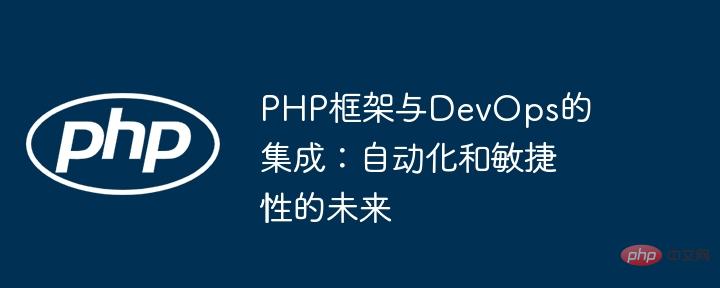Home >Backend Development >PHP Tutorial >Integration of PHP frameworks with DevOps: the future of automation and agility
Integration of PHP frameworks with DevOps: the future of automation and agility
- WBOYWBOYWBOYWBOYWBOYWBOYWBOYWBOYWBOYWBOYWBOYWBOYWBOriginal
- 2024-06-05 21:18:00910browse
Integrating PHP frameworks with DevOps improves efficiency and agility: automates tedious tasks, frees up personnel to focus on strategic tasks, shortens release cycles, accelerates time to market, improves code quality, reduces errors, enhances cross-functional team collaboration, and breaks down development and operations Silos

Integration of PHP Framework with DevOps: The Future of Automation and Agility
In today’s rapidly evolving world of software development, Integrating PHP frameworks into DevOps practices has become key to improving efficiency and agility. This article will guide you through the benefits of this integration and provide a practical example of how to automate using Laravel and CI/CD tools.
Benefits of Integration
- Automated tasks: DevOps tools automate tedious tasks such as code deployment, testing, and monitoring, Free people to focus on more strategic tasks.
- Shorten release cycles: By automating the process, teams can release new features more frequently, thereby reducing time to market.
- Improve quality: CI/CD tools automate testing and inspections to ensure high code quality and reduce errors.
- Enhanced Collaboration: DevOps integrations promote transparency and collaboration among cross-functional teams, breaking down traditional development and operations silos.
Practical case: Using Laravel and CI/CD
1. Set up the CI/CD pipeline
- Create a free GitLab or Jenkins account.
- Set up CI/CD pipeline in Git repository.
- Configure the pipeline to trigger the CI/CD process on every code commit.
2. Integrate Laravel
- Install the Laravel framework.
- Add unit tests to your Laravel project.
- Add a PHPUnit test step in the pipeline configuration.
3. Automate builds and deployments
- Add Composer installation steps to the pipeline.
- Configure the pipeline to automatically build code into application images.
- Set the deployment steps to deploy the image to the target platform (such as Amazon EC2 or Kubernetes).
4. Real-time monitoring
- Integrate monitoring tools (such as Prometheus or Sentry) into the application.
- Configure the pipeline to monitor your application's metrics and exceptions.
- Set up an alert mechanism to notify the team about issues.
Conclusion
By integrating PHP frameworks with DevOps tools, development teams can unlock the powerful benefits of automation, agility, and quality. This practical case demonstrates how the combination of Laravel, CI/CD, and real-time monitoring enables teams to deliver high-quality software quickly and efficiently. Embrace DevOps best practices and combine the power of the PHP framework with the advantages of automation and collaboration to lay the foundation for improving software delivery capabilities.
The above is the detailed content of Integration of PHP frameworks with DevOps: the future of automation and agility. For more information, please follow other related articles on the PHP Chinese website!

